Monday at 5 pm public comments on the Boston Creates Cultural Plan will close. (The full text of the plan draft can be read here along with community comments, including my own). We encourage you to read the Cultural Plan and the comments and share your own thoughts below if you miss the opportunity to respond to the draft directly. What follows is an elaboration on those comments—my initial reaction after reading the plan and after speaking to a number of artists and members of the community. For a great, succinct overview of the plan, I recommend Jeremy Goodwin's piece in The ARTery).
The task at hand to develop a cultural plan is a daunting one and I applaud the efforts that went into creating this document and trying to get a full, clear picture of the arts ecosystem in Boston. Since the draft was made public, a significant amount of apprehension has been vocalized and I think the main source of anxiety coming from the community is tied to the magnitude of the plan. With the city (and its leadership) in a state of transition, this feels like our last, best chance to affect large-scale positive change and rightfully, many of us are skeptical that any of this change can be implemented.
The document is aspirational and sets goals to address problems that are systemic, yet most of the 40-page plan seems to focus on underscoring the importance of the arts in our community—and justifying it to those who need to be convinced—rather than providing specific concrete measures to bring about that change. 10–15 years is a long time and smaller, targeted plans have, in the past, been proposed and have fallen by the wayside. Why aren't there assessment periods listed within the plan to provide opportunities to address the inevitable need for accountability and course correction? I recognize that this is just a draft and it even notes that the final document "will incorporate public feedback, include some new sections, and share more details about implementation," but it is hard to trust that it will be properly implemented when we see the House Ways and Means Committee consistently propose deep cuts to arts funding.
We as a city value the wealth of creative individuals and cultural institutions based here, as evidenced by the length of this process and the Mayor publicly prioritizing the arts in a way other administrations have not. So, why does the rhetoric constantly leverage the arts in a way that argues their ability to bring about ‘vitality,’ which reads as a codeword for economic growth?
Working in higher education, I understand that the arts and humanities constantly have to defend their relevance, but is there a point at which we can be supporting art for art’s sake? Partially, I know that this impulse stems from my own naiveté but also my philosophical rejection of the wholesale acceptance of the concept of creative capital, of how it is often the only way to convince policymakers to back initiatives like the one we are weighing. The rhetoric of neoliberalism is one thing; its reality and manifestation are another. We, as creatives and cultural workers, are asked to eat our prestige in the midst of economic growth that never reaches us—the closest we get to it is when we get evicted.
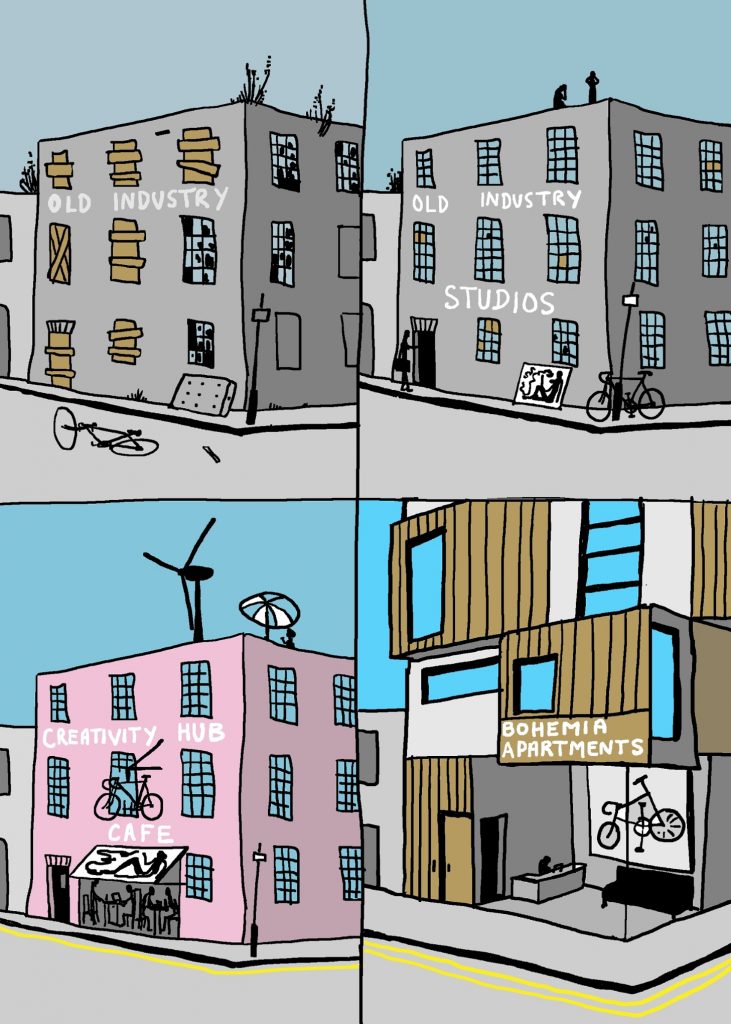
Gentrification
Illustration: Grayson Perry
This brings me to the one area where I had time to comment directly on the document: the issue of affordable housing, which the plan cites as being a critical component of our deficient infrastructure for the arts, and which I believe is one of the most important. When addressing this need, however, it only defines affordable housing in relation to artists (primarily live/work). It should be kept in mind that the issue of affordable housing not only affects artists in Boston but realistically anyone in the lower 60th percentile of income. For example, those individuals who staff both the large institutions and smaller nonprofits, who provide support and dialogue for the city’s artists, face similar difficulties as our artists and are disappointingly mentioned only in passing throughout the plan. Though these roles are perceived as separate, they are deeply related and often interchangeable, with cultural workers moonlighting as artists and vice versa. Whether or not they themselves identify as practicing studio artists, the workers who are employed at local cultural organizations are invaluable to our arts ecosystem, and also struggle with job security and area rents.
While more live/work spaces in this city are needed and desired, even those tend to be out of reach for most artists, either financially (at times because artists are making more than the AMI cap on a space, yet the rent would still be difficult to meet on a unit that meets their AMI) or administratively (because, as Dustin Todd Rennells points out in his comment on the plan, the process of applying for live/work spaces can take weeks or even months, includes a lottery, and still you can be passed over for incorrectly filling out a form). And once these units are designated or built, housing and rent prices in the surrounding neighborhoods often skyrocket, driving out working families and long-time residents.
It is important to acknowledge that most artists in Boston do not derive even a small fraction of our income from our creative work—we often balance at least a few part-time jobs or a full-time job (most likely in higher education or other cultural nonprofits) with making art, and while live/work space would be incredible for us, the more important need, in my opinion, is to have a place to sleep at night. Despite the desire and need for separate studio space, many artists adapt their current living situations to work at home, navigating whatever restrictions the space may have. It’s not unusual for artists in Boston to work in basements or in bedrooms or on kitchen tables. Though not ideal, a stable, affordable housing situation is the baseline that allays fears and allows for creative work to begin.
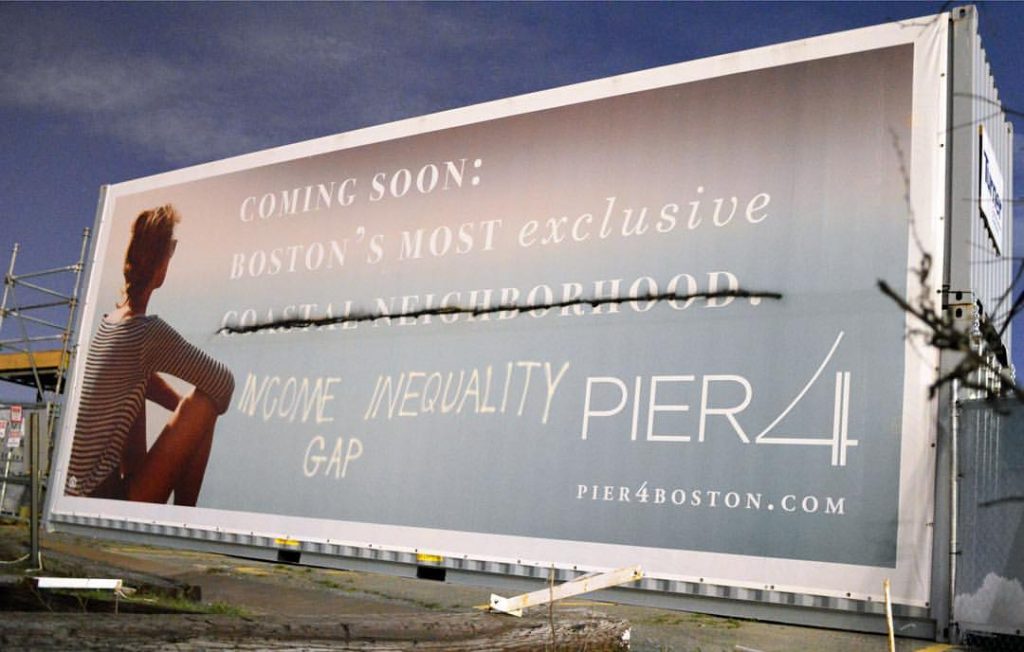
Altered Pier4 apartments banner in the "Seaport District" by the ICA Boston. Photo: Pat Falco
What I find most frustrating is that we've encountered all of this before. In the very first issue of Big Red & Shiny in 2004, we published an essay by Meg Rotzel, the former director of the now-closed Berwick Research Institute, speaking, in part, about its closure and being an artist in Boston. In it she wrote:
The truth is that we can’t afford it here—we can’t afford to pay rent and fund our own projects. There are only a few agencies that fund artists who make work that is outside of the museum or educational context. The Massachusetts Cultural Council recently had their budget cut by more than half. Space is limited—our lofts have been taken over by short-lived startups and big city real estate agencies. Our public spaces are so closely governed by increasingly strict laws that something as harmless as a spontaneous happening or a public intervention can easily be misconstrued.
What’s worse is the fact that we are a fragmented community. One Berwick supporter recently commented to me that he was surprised that Boston’s artist community seemingly had deaf ears in regards to the recent demise. But many of the community’s defenders have been killed off by bad public policy and shady real estate deals. The community has been so pummeled that it is often hard to just show up.
It is disheartening to realize that though 12 years have passed since this was written, we are still facing the same problems and sentiments because adequate solutions were never proposed. Why can't our population support non-commercial art spaces? Why haven't we invested more in the public infrastructure? Why are neighborhoods that were once diverse in race, commerce, and culture still being sanitized and paved over in favor of glossy developments of luxury condos that sit mostly empty for years while being both an eyesore and a reminder that we are no longer welcome?
This isn't to say that we haven't made some progress in specific areas with varying degrees of success, but the unspoken danger in all of the outlined proposals is whether or not they can be made sustainable without steepening the housing rent gradient or increasing the suburbanization of middle- and lower-income workers. It is hard to deny that creative epicenters in the U.S. show some of the highest socioeconomic inequality, so is a plan like this one just another signal that more gentrification is coming up the rear? Are there ways to mitigate this? Have they been addressed? Is it even possible?
As encouraging as it is to see the city publicly address some of our greatest collective anxieties, it’s still hard not to wonder: are we damning ourselves if this plan is successful? Are we damning ourselves if it fails?

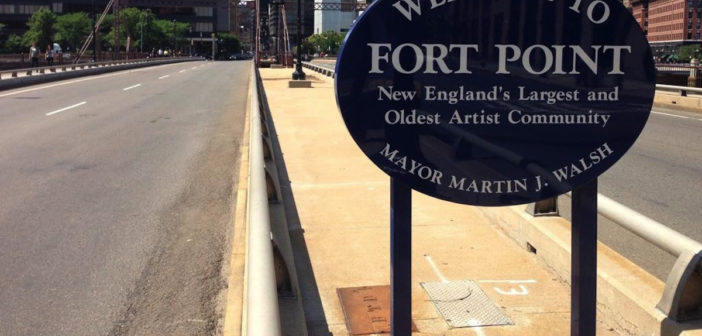
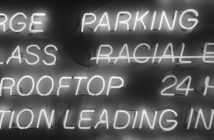
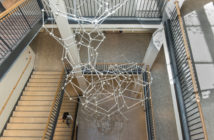
1 Comment
Excellent article, Brian. You’ve summed up many of the issues faced today by area residents, not only those who make up the the arts and culture space, but also in the big industries of education and health care. All of these people can’t afford to live in the areas that are being touted as hip, or up and coming. And let’s face it, what makes them hip and up and coming is arts and culture. Once again, the artists are pricing themselves out of a home. How do we stop this nonsense? Developers aren’t interested in providing homes. They’re interested in making money, and lots of it. And truthfully, who isn’t?